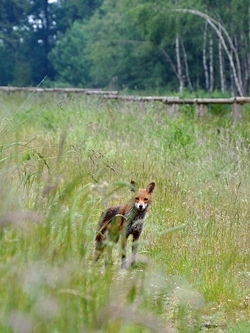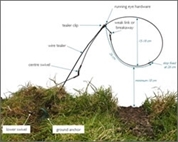 Snares are unique, in that they catch only when the animal is completely unaware of their presence. Foxes are highly ‘neophobic’ - they have a tendency to avoid anything new. A fox which detects a snare will avoid it. It may not be unduly alarmed, but it is unlikely ever to be caught in that particular snare set. This is because it will trot round it, probably examining it by sniffing. It may well scentmark it, which draws it to the attention of other foxes. They don’t know what it is, but it’s an odd item in their landscape. There’s nothing particularly crafty about this – dogs behave much the same way; they’re usually just a lot less acute.
Snares are unique, in that they catch only when the animal is completely unaware of their presence. Foxes are highly ‘neophobic’ - they have a tendency to avoid anything new. A fox which detects a snare will avoid it. It may not be unduly alarmed, but it is unlikely ever to be caught in that particular snare set. This is because it will trot round it, probably examining it by sniffing. It may well scentmark it, which draws it to the attention of other foxes. They don’t know what it is, but it’s an odd item in their landscape. There’s nothing particularly crafty about this – dogs behave much the same way; they’re usually just a lot less acute.
Foxes that have ‘spotted’ a snare can still be caught in another snare which has not been detected. Indeed, it’s possible to catch foxes in snares several times over, as we have found when catching foxes for radio-tagging. In one study, we caught the same dog fox on five occasions while trying to catch an untagged fox known to share the same territory; we had to abandon this to avoid catching him again. The action of a snare is not as alien to a fox as one might imagine: being snagged by brambles is probably an everyday experience. The fox just backs off, then carries on. We have watched a fox do exactly this when a snare drew up round its nose. It was clearly not alarmed, and was properly caught the next day after the snare was re-set a metre further along the run.
So you don’t want your snares to have an obvious presence. Physically, all snares are minimalist devices. Some more than others: as with bicycles, if you pay more money, your snare can have better components which are smaller and neater for the same strength. You can colour the snare so that it is almost impossible to see, even when set in an open field. But a central message of this leaflet is that minimising scent cues is also crucial to success. Foxes have an acute sense of smell, so snares must also have an insignificant scent profile to escape detection. Bear in mind that a dog can trail a man wearing clean boots by following the scent of bruised vegetation, hours after the trail was made. Dogs are amateurs. Foxes are professionals – their lives depend on it.
If you catch your fox quickly, you should end up using your snares less, and will therefore catch fewer non-targets. Most non-target species at risk of capture in snares are much less perceptive of scent cues than foxes are. Therefore if you ignore scent you are likely to catch more non-targets for every fox caught.
Get your FREE fox snaring guide from the GWCT team
Simply enter your email address below to download your essential free guide.
 What's inside your FREE fox snaring guide
What's inside your FREE fox snaring guide
✓ Fox control: Is it important?
✓ What are the alternatives to snaring?
✓ The main components of a well-designed snare
✓ Fox snares: Hardware vs practice
✓ Key controversies
Download free >